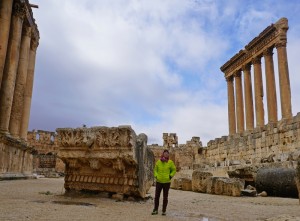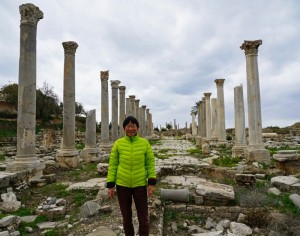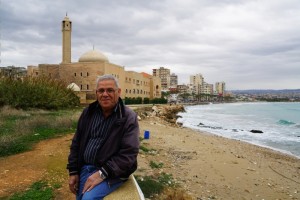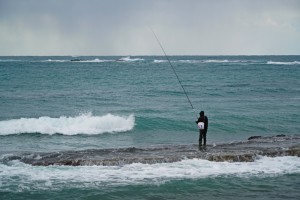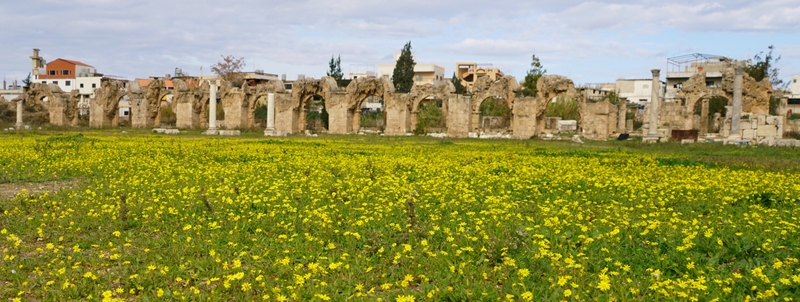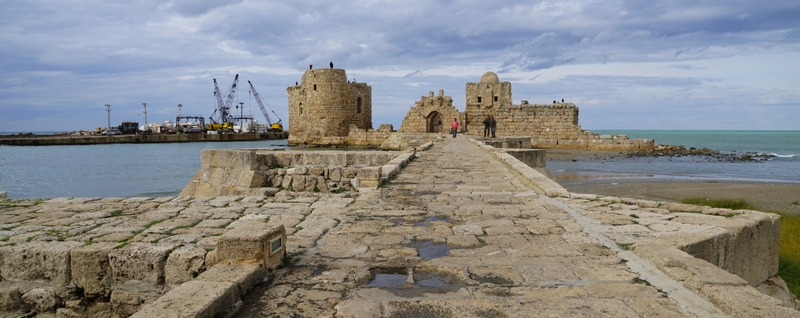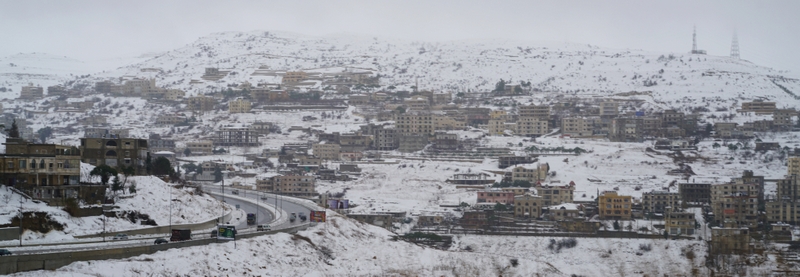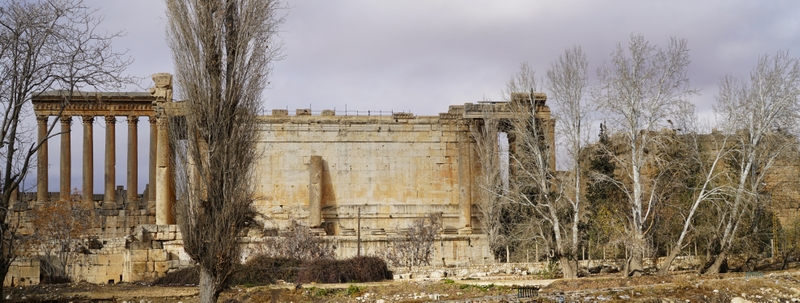January 2 &3, 2016: Tyre, Maghdouché, Sidon & Baalbak, Lebanon; January 4-6, Doha, Qatar
January 2 Saturday: Tyre, Maghdouche & Sidon
When I saw Renee at 7:30am, I knew something was wrong. She had fever and had no sleep: her voice was coarse and eyes puffy. Both Antonio and Renee were too sick to go. When the driver, Mohammed turned up at 8 am, I discussed the problem with him. He finally agreed to take me to three places of interest for $100.
First Stop: Tyre (80km south of Beirut)
Tyre according to legend, the purple dye was invented in Tyre, the great Phoenician city that ruled the seas and founded colonies such as Cadiz and Carthage. Its historical role declined at the end of the Crusades. It however conserves important archaeological remains mainly from Roman times.
This World Heritage property consists of two distinct sites. The first site by the sea comprises important archaeological vestiges, a great part of which is submerged. The most noteworthy structures are the vestiges of the Roman baths, two palaestrae, the arena, the Roman colonnaded road, the residential quarter and the remains of the cathedral built in 1127 by the Venetians and some of the walls of the Crusader castle.
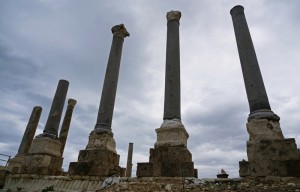 |
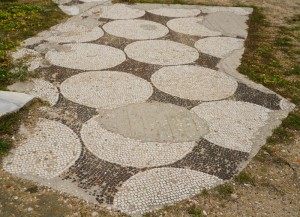 |
The second site includes the Necropolis of El Bass which consists the principal entrance of the town in antique times. Remains of the necropolis can be found on either side of a wide monumental causeway dominated by a Roman triumphal arch dating from 2nd century AD. Nearby is an impressive Hippodrome of the same period, one of the largest of the Roman world. To save time, I brought a grilled chicken (1,000 LBP) for lunch before heading to Maghdouché.
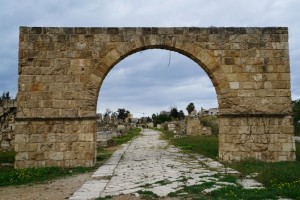 |
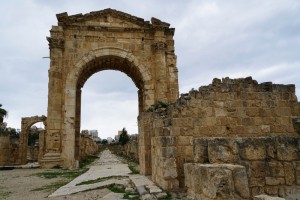 |
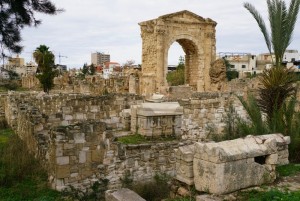 |
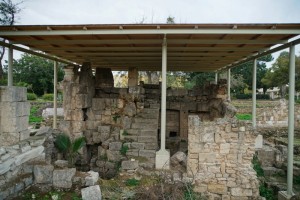 |
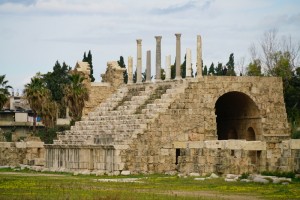 |
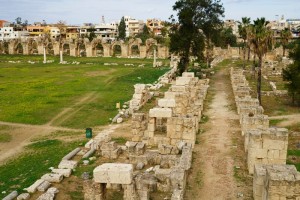 |
Second Stop: Maghdouché
Most visitors come here to visit a holy Christian site called ‘Our Lady of Mantara‘(also known as Our Lady of Awaiting) and a Marian shrine. The shrine consists of a tower crowned with the statue of the Virgin and Child, a cathedral, a cemetery and a sacred cave believed to be the one where the Virgin Mary rested while waiting for Jesus to finish preaching in Sidon. Mohammed and I had a picnic lunch while enjoying panoramic views of Sidon and the region.
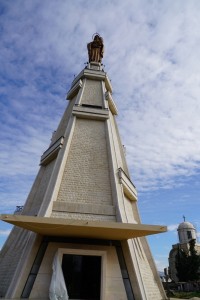 |
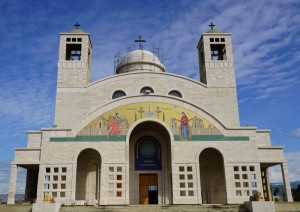 |
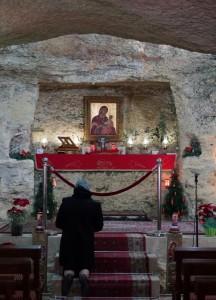 |
Last Stop: Sidon (40km south of Beirut)
Sidon is the third largest city in Lebanon. In Genesis, Sidon is a son of Canaan and a grandson of Noah. Sidon was one of the most important Phoenician cities and may have been the oldest.
Mohammed dropped me off at the Sea Castle, a fortress built by the Crusaders in the early 13th century. It is located near the Port of Sidon. The castle is small but atmospheric.
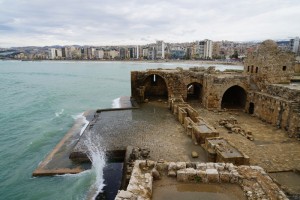 |
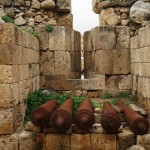 |
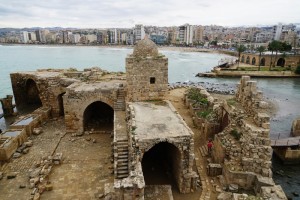 |
I wandered around for almost an hour before walking across the road to visit the Old Souk, a historical vaulted market. The people are nice and polite to strangers: I enjoy watching the locals shopping and conducting their daily business. Though I was the only tourist there, I felt free, safe and welcomed.
I returned to Beirut at 2:30 pm and asked Mohammed to drop me off at the National Museum. Built between 1930 and 1937, the museum is not big but well-designed with good illustrations in English. There are many interesting items from Byblos including statues and a sarcophagus.
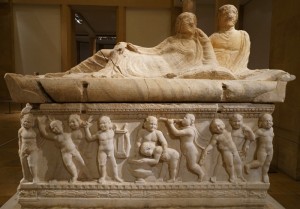 |
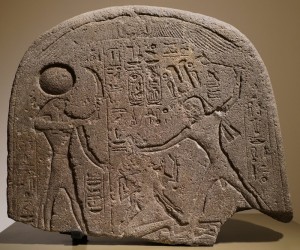 |
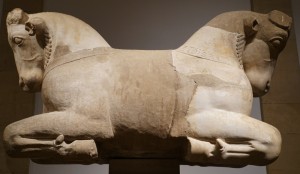 |
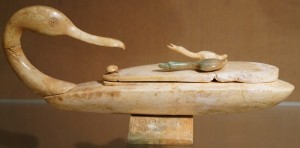 |
I left the museum at 4:30 pm and walked back to hotel. It got dark very quickly and I had taken a wrong turn which led me back to the down town area. Nonetheless, this route took me through the area close to the Presidential Palace which are all cordoned off limit with barb wire. Few people were walking on the street and I felt a bit uneasy for the first time on this trip.
It was almost 7 pm when I got back to the hotel and bumped into Renee and Antonio. They felt better and were planning to get a taxi to visit Baalbak the following day. Savio, who speaks English and has a 4WD, charged them $125 for a day. I gladly joined them to Baalbak.
January 3 Sunday: Baalbak (85km northeast of Beirut and 75 km north of Damascus, Syria)
Baalbak (a World Heritage Site) was the seat of worship to a triad of deities. It retained its religious function in Roman times when the sanctuary of Jupiter drew thousands of pilgrims. It was first a centre of pagan worship. The Phoenicians later transformed it in honour of the god Baal. After the conquest of Alexander, Greek settled here and named it Heliopolis (City of the Sun). With its colossal structures, Baalbak is one of the most impressive examples of Imperial Roman architecture at its apogee and one of most ancient cities of the world. Crusaders were here too. As a result, a citadel, a great mosque, temples of Jupiter, Bacchus and Venus are all located at this magnificent site.
To reach Baalbak, it is necessary to take the highway that crosses Mount Lebanon before descending to Beqaa Valley. Since it had been snowing for two days, Savio was not sure whether the highway was open. Thanks to his powerful 4WD and driving skills, we managed to cross the pass which was covered with deep snow. Many cars without snow tyres and in poor conditions could not make it. They got stuck or stopped on the road side to put on the snow tyre. Many drivers have no safety sense and pose danger to other road-users.
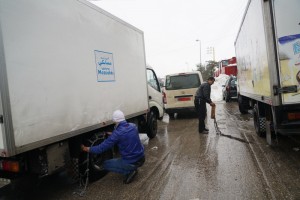 |
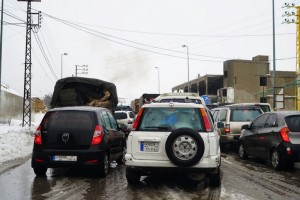 |
We took two hours to get to Baalbak. On the way, we saw several Syrian refugee camps. Savio also pointed out a large Palestinian camp. We had a quick stop at an ancient quarry that had provided the stones for construction. As it was slightly higher than the complex, no lifting was required to move the stones. I saw the world’s oldest ancient stone which was uncovered in 2014 and the ‘Stone of the Pregnant Woman’ weighing some 1,000 tons.
Baalbak Temple Complex
Fortified as the town’s citadel during Middle Ages, the temple complex was constructed from local stone, mostly white granite and a rough white marble. This world heritage property possesses some of the best preserved Roman ruins in Lebanon. Located on an immense raised plaza erected 5m over an earlier T-shaped base, the complex consisted of a podium, staircase, and foundation walls. The walls were built from about 24 monoliths, at their lowest level weighing approximately 300 tons each. The tallest retaining wall, on the west, has a second course of monoliths containing the famous “Three Stones”: a row of three stones, each over 19m long, 4.3 high and 3.6m broad, cut from limestone. They weigh approximately 800 tons each. Through the foundation there run three enormous passages the size of railway tunnels.
- Entrance from the east through the Portico consisting of a broad staircase rising 6.1m to an arcade of 12 columns flanked by two towers. Most of the columns and the stairs were gone but a Latin inscription remains on several of their bases.
- Hexagonal Forecourt
- Rectangular Great Court covering around 1.2-1.6 ha including the main altar for burning offering with mosaic-floored illustration basins to its north and south, a subterranean chamber and three underground passageways. These were surrounded by Corinthian porticoes. Only six out of the original 128 remain standing.
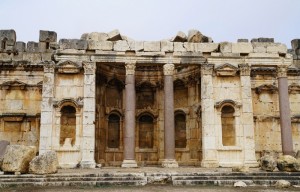 |
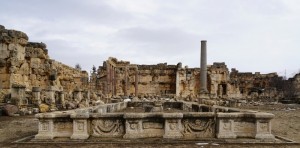 |
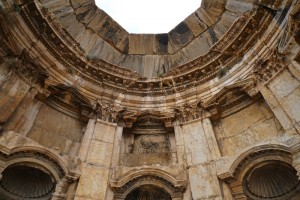 |
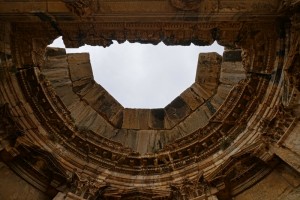 |
- Temple of Jupiter (1st century AD) lying at the western end of the Great Court raised another 7m on a 47.7m x 87.75m platform and reached by a wide staircase. The temple proper was circled by a peristyle of 58 unfluted Corinthian columns: 10 in front and 19 along each side. Today only 6 columns remain while some had ruined by earthquakes, destroyed and pillaged for stone under Theodosius, 8 taken to Constantinople (Istanbul) under Justinian for incorporation into the Hagia Sophia, three fell during the late 18th century.
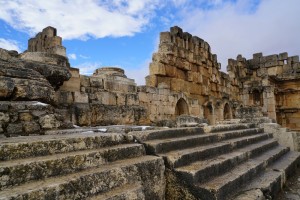 |
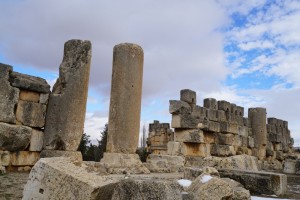 |
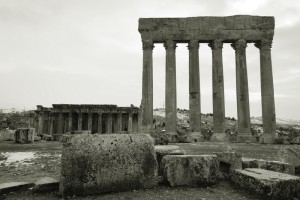 |
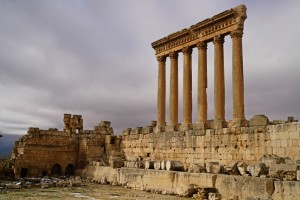 |
- Temple of Bacchus, the best preserved of the sanctuary’s structures, is surrounded by 42 columns – 8 along each end and 15 along each side, nearly 20m high. The temple was damaged by the 1759 earthquakes. The interior of the temple is divided into a 30m nave and an 11m sanctuary on a platform raised 2m above it and fronted by 13 steps. Restoration work is going on and we could not enter the temple. A keeper took us to see a small museum nearby.
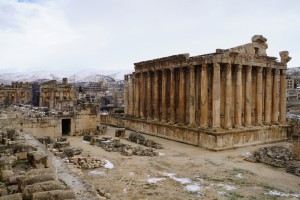 |
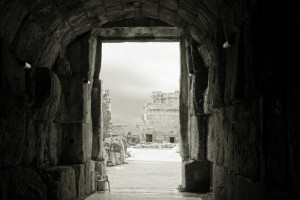 |
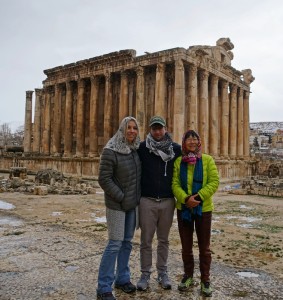 |
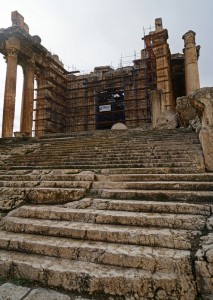 |
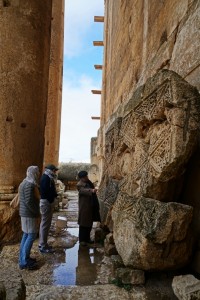 |
- Temple of Venus built in the early 3rd century AD but destroyed under Constantine lies outside the main complex.
- Ancient walls of Heliopolis had a circumference of about 6km. Much of the extant fortifications around the complex date to the 13th century reconstruction undertaken by the Mamluk sultan Qalawun.
We hired a local guide for $20. However, he gave explanations and a bit of history like a record. He was annoyed with me as I walked slowly and trailed behind taking photos. Anyway, I have learnt more about this extraordinary archaeological site and its history from Wikipedia and the UNESCO website.
Though we had spent almost three hours there, I felt I had not seen enough as there are too much to see. Savio urged us to leave at 2 pm the latest as the road would be congested. He was right. We took three hours to return to Beirut. We passed an area in the mountain with many dilapidated and deserted mansions and hotels. Savio said the Christian owners had fled the country during the civil war.
January 4 Monday: Beirut, Lebanon – Doha, Qatar (GMT+3)
My flight to Doha would depart before 1 pm. I got up early and strolled around the quiet and quint Hamra neighbourhood before taking a taxi ($20) to the airport at 10:30 am. The plane took off on schedule and I arrived in Doha shortly after 5 pm (local time)
Remarks (written in Hong Kong in February 2016)
Lebanon has always been on my wish-list for several reasons. It first caught my attention in late 1970s when the country was embroiled in civil war. Bad news of atrocities and incessant fighting broke my heart. Then the rise of PLO and later Hezbollah have caused intermittent problems with Israel. Turbulent events in Syria and the rise of Islamic State in recent years have impacted on Lebanon. It has survived and I want to see this amazing country.
Secondly, I have come to learn more and more about the glorious past of the Phoenicians who came from today’s Lebanon during my visits to Mediterranean and Middle East countries.
Thirdly, I had my first taste of Lebanese cuisine while working in London. The food is so delicious that I believe the country must be worth visiting (though I am not a foodie).
Finally, though I am not a country-ticker, I am keen to visit all the 21 nations with coastlines along the beautiful Mediterranean Sea. By the end of 2014, I had been to all except Lebanon and Libya. As a matter of fact, I had joined a Christmas tour to Libya in 2009. But my dream was shuttered as I was unable to get a visa (I went to Cuba instead).
Luckily Lebanon is open and tourist friendly and Lebanon exceeds my expectations.
First, Lebanon is rich in history. It boasts five World Heritage Sites despite its small size. Standing in the ruins in Byblos, the world’s oldest city (or one of the oldest) and Tyre, I can imagine the maritime and commercial power of the Phoenicians from 1500 BC to 300 BC. The grandeur and scale of Baalbak is awesome and a ‘must-see’. The Roman Hippodrome in Tyre, the largest of its kind is impressive. It is a pity that I miss two World Heritage Sites namely Anjar (a city founded by Caliph Walid I at the beginning of the 8th century with a methodical layout and reminiscent of the palace-cities of ancient times – a unique testimony to Omayyad city-planning) and Ouadi Qadisha (Holy Valley, one of the most important early Christian monastic settlements in the world with monasteries located dramatically in a rugged landscape) and the Horsh Arz el-Rab (the forest of the Cedars of Lebanon highly prized cedars for construction of great religious buildings in Antiquity).
Second, Lebanon is easy to move around. I stayed in Beirut and made three day trips to Byblos, Tyre and Baalbak. Despite the visible war scars of the civil war, barbed wire and presence of check-points and guards in the capital and near Tyre (close to the border with Israel), the country today is functioning reasonably well. The local minibus system provides a cheap way to travel around. I find the Beirut airport most efficient as compared with those in other Middle East countries. Taxi/car hire is not expensive. I have travelled on the main north-south highway along the Mediterranean coast which is good. The road to Baalbak and Syria over Mount Lebanon mountain range is not bad (of course, it is bumpy in some parts).
Third, Lebanon is unique. Given the long history of Christianity and large presence of Christians and internationals in Beirut, the capital has an open, liberal and cosmopolitan feel with an enchanting mix of Christian and Islamic influences (which I have not experienced in other Middle East countries). When I walked around and visit markets and shops in Beirut, Tyre, Sidon, Byblos and Baalbak, I found the locals (both Christian and Muslim) carry on their life, move around freely and look relaxed.
Fourth, Lebanon is resilient. The country has been suffering during the civil war and badly hurt and messed up as a result of regional problems and conflicts. Today, it has some 2 million refugees. I find the turbulent history of Middle East most intriguing. Though Lebanon has made progress since the end of the civil war, it is still beset with problems including political instability and internal division along sectarian lines, corruption, refugees and infrastructural development.
My First and Lasting Impressions of Lebanon
Few places on earth would evoke deep emotions in me these days. Lebanon is one of those rare places. My friends consider Lebanon and the Middle East dangerous and say I am crazy to visit Lebanon. I have the following to say to my friends and for Lebanon.
- We live in a crazy world and terrorised by extremists, terrorists and lunatics. Anything can happen anywhere. I believe in destiny: one can die anytime anywhere. Despite Lebanon’s rich history, natural beauty and cultural heritage, international tourists are too scared to visit it. What a pity!
- Lebanon is civilised and beautiful. Beirut is vibrant, cosmopolitan and a gem. Things are working reasonably well.
- The Lebanese have indeed had a hard time and life has been difficult. They understandably have their own psyche owing to the ferocious civil war and aftermaths. Today, they are still worried about the future of their divided country along sectarian lines, the unstable government and fragile economy, the rising cost of living, the ongoing civil war in Syria, the Palestinian problem, the Islamic State etc. The few people with whom I have spoken are uneasy over the declining Christian population especially in Beirut and fear the country would be dominated by the Muslim faction. I can understand their concern and only pray Lebanon’s free spirit and openness will continue even when the Lebanese population is in clear majority.
- On my way to Baalbak, my heart sank whenever the driver pointed at a Palestinian and Syrian refugee camp. Politics in the Middle East is incomprehensible and seems getting out of control. What can be done to bring peace? How can be done for the oppressed and the refugees? I feel helpless and hopeless.
- I believe Lebanon merits international recognition and support for providing shelter for some two million refugees and keeping the country together.
I plan to return to Lebanon one day to explore the rest of the country. I hope the country will be able to move on achieving political and social stability and economic prosperity. This will happen if this small country is spared of ongoing wars and conflicts in its neighbouring countries.


